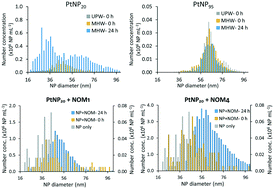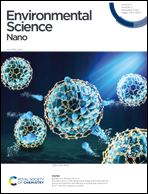Nanoparticle size and natural organic matter composition determine aggregation behavior of polyvinylpyrrolidone coated platinum nanoparticles†
Abstract
Engineered nanoparticle (NP) size and natural organic matter (NOM) composition play important roles in determining NP environmental behaviors. The aim of this work was to investigate how NP size and NOM composition influence the colloidal stability of polyvinylpyrrolidone coated platinum engineered nanoparticles (PVP-PtNPs). We evaluated PVP-PtNP aggregation as a function of the NP size (20, 30, 50, 75, and 95 nm, denoted as PVP-PtNP20–95) in moderately hard water (MHW). Further, we quantified the effect of the hydrophobic organic acid (HPOA) fraction of NOM on the aggregation of PVP-PtNP20 and PVP-PtNP95 using 6 NOM samples from various surface waters, representing a range of NOM compositions and properties. NOM samples were characterized for bulk elemental composition (e.g., C, H, O, N, and S), specific ultraviolet absorbance at 254 nm (SUVA254), and molecular level composition (e.g., compound classes) using ultrahigh resolution mass spectrometry. Single particle-inductively coupled plasma-mass spectrometry (sp-ICP-MS) was employed to monitor the aggregation of PVP-PtNPs at 1 μg PVP-PtNP per L and 1 mg NOM per L concentrations. PVP-PtNP aggregate size increased with decreasing primary PVP-PtNP size, likely due to the lower zeta potential, the higher number concentration, and the higher specific surface area of smaller NPs compared to larger NPs at the same mass concentration. No aggregation was observed for PVP-PtNP95 in MHW in the presence and absence of the different NOM samples. PVP-PtNP20 formed aggregates in MHW in the presence and absence of the six NOM samples, and aggregate size increased in the presence of NOM likely due to interparticle bridging of NOM-coated PVP-PtNPs by divalent counterions. PVP-PtNP20 aggregate size increased with the increase in NOM elemental ratio of H to C and the relative abundance of lignin-like/carboxyl rich-alicyclic molecules (CRAM)-like compounds. However, the aggregate size of PVP-PtNP20 decreased with the increase in NOM molecular weight, NOM SUVA254, elemental ratio of O to C, and the relative abundance of condensed hydrocarbons and tannin-like compounds. Overall, the results of this study suggest that the composition and sources of NOM are key factors that contribute to the stability of PVP-PtNPs in the aquatic environment.

- This article is part of the themed collection: Environmental Science: Nano Cover Art


 Please wait while we load your content...
Please wait while we load your content...
